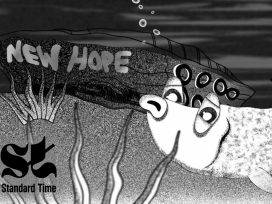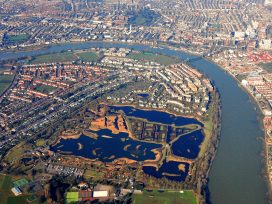The politics of nature in the Anthropocene
In dialogue with Dipesh Chakrabarty, Kathleen McAfee considers the grounds on which a politics of broader solidarity can and must emerge in the face of an unprecedented ecological turning point; a turning point that is simultaneously a crisis of subsistence for billions of people, albeit to different degrees and in different ways.
Over the past four decades, Nature has entered global politics. In contentious treaty negotiations on climate change and biodiversity, governments are pressed to take action in response to the planetary ecological crisis. In conservationist discourse more broadly, this upper-cased construct is represented as a singular nature under siege by society. Nature, we are told, is damaged and becoming dangerously scarce: witness overflowing carbon sinks and imminent climate catastrophe, disappearing species and vanishing ecosystems, and insufficient land, water, and food for a burgeoning humanity. But for whom, and why, has this nature become scarce?
The politics of nature cannot be neutral. Like all politics, ecopolitics is ultimately about who is entitled to what, who owes what to whom, how such rights and entitlements are to be enforced, and who gets to decide. In a world of great geographic variety and vast social difference, decisions and actions by states and others, or inactions opting for the status quo inevitably have consequences that affect some people and places very differently than others. How the natural world, and humans’ role in it, are conceptualized helps to determine the menu of choices deemed preferable, possible, or beyond the pale.
The notion of scarcity itself is a political concoction that masks immense waste, obscene concentrations of wealth, and the self-defeating pursuit of endless economic growth. In the past decade or so, scholars trying to come to terms with global warming and the supposed scarcity of “ecological space” have embraced the idea of the Anthropocene age to acknowledge the scale and unprecedented rapidity of anthropogenic global change. Some accounts link the Anthropocene concept to a posthumanist turn in social and cultural studies and reject dualist distinctions between society and nonhuman nature.1 But the representations of nature and the nature-society nexus in many narratives of the Anthropocene too easily lend support to one particular set of options and interests while obscuring others.
In Dipesh Chakrabarty’s “Four theses”, the Anthropocene signals that “humans” are now a “geological force”. Embrace of the Anthropocene becomes the basis of a renewed universalism in which “reason”, linked to a 250-year quest for “freedom”, is seen as key to global collective action. The new status of humans is said to abolish the separate categories of nature and society – old news for most critical social theorists – but at the same time it seems to trump postcolonialism’s questioning of universals. But is species-level human action possible?2
Even if “we can become geological agents only historically and collectively”,3 this is inevitably a social and political process, where agency is wielded through collective actions by particular groups of people. Chakrabarty defers to prominent natural scientists as nature’s interlocutors: the only qualified witnesses and guides to the likely, although uncertain, trajectory of global change. Invoking the power of Enlightenment reason, he cites E. O. Wilson, Harvard entomologist and biographer of another recent construct, biodiversity: “We know more about the problem now […] . We know what to do”.4 Chakrabarty also quotes chemist and Nobel laureate Paul Crutzen and biologist Eugene Stoermer, the pair generally credited with introducing the Anthropocene concept: “An exciting, but also difficult and daunting task lies ahead of the global research and engineering community to guide mankind towards global, sustainable, environmental management”.5
Crutzen, Stoermer, Wilson, and similarly engaged natural scientists are not the first spokespeople for nature. As a student of postcolonialism, Chakrabarty is surely aware of how the nature ideal has been deployed over the past five hundred or more years by the global research and engineering communities of their days as a justification for conquest and dispossession. Claims of superior, scientific knowledge, often flying in the face of deep local knowledge and experience, have supported major projects for reordering landscapes, frequently with disastrous consequences and nearly always with inequitable results.
A brief sampling might note the ill-fated hydrological reengineering of Tenochtitlán, the replacement of community forests by scientifically managed imperial woodlots, the substitution of Cartesian-grid, monocrop planting for native polycultures adapted to local soils and rains, the violent suppression of women’s practical healing knowledge by an all-male medical elite, the new enclosures of landscapes and forests by today’s agro-efficiency engineers and would-be “global” conservation organizations acting in the name of nature and the best interests of “humanity”. One need not deny the power of Enlightenment reason, or dismiss the achievements of scientific method in engineering and medicine, to be justifiably leery of agendas to “guide mankind” with knowledge – and, as strongly implied, superior values – possessed by an unspecified “we”. Clearly Wilson’s “we” is not the same “humanity” that he has described as the “planetary killer”, but rather is one small subset, to which he belongs, of the human species.
I suspect that Chakrabarty would agree with much of the above. But perhaps in adopting a new planetary discourse of the Anthropocene he has turned his critical gaze away from the power-laden deployments of nature and claims to unique expertise that have framed “global” conservationism and policymaking on climate change. The notion of a unique, Western appreciation of nature that legitimized mass displacements for game parks is marshalled today in support of new enclosures for biosphere reserves, carbon banks, “climate smart” industrial farms, and other forms of what critics call “green grabbing”.
The most widely influential idea in contemporary conservation discourse is still the “tragedy of the commons”, the vision of Garrett Hardin, credentialed microbiologist, self-proclaimed ecologist, crusader for population control, and dabbler in scientific racism. While Hardin’s metaphor of the selfish pastoralists who destroy their own livelihood has been amply debunked by ecologists and scholars of local collective action, his notion that nature will take its revenge on humanity, or at least on the undeserving majority of us, lives on as a subtext in neo-Malthusian imaginaries of autonomous nature such as James Lovelock’s Gaia hypothesis. If Hardin’s and Lovelock’s visions can be disregarded as pseudoscientific outliers, the idea that nature itself has set measurable limits on human activity, limits to which formal science alone is privy, has taken on new life in the context of deepening concerns about climate change and shrinking “resources”.
For several decades, the 1970s theories of “limits to growth” were pushed to the background by the technological optimism and fixation on competitive growth of the neoliberal 1980s, 1990s, and 2000s. The limits thesis was then revived, and linked to the Anthropocene concept, notably with the 2009 publication by Johan Rockström, Will Steffen, and colleagues of “Planetary boundaries: Exploring the safe operating space for humanity”, which postulates nine biophysical tipping points beyond which “irreversible and abrupt environmental change is almost certain to occur”.6
Subsequent debates about the parameters of such limits have involved geoscientists primarily, alongside economists – presumably the most scientific of social scientists – and other environmental policy advocates. Among the latter are post-environmentalists who contend that we enlightened humans must now acknowledge our role as co-creators, for better or worse, of the more-than-human world and resolve to make the best of what we have wrought. Tenets of this new conservationism are that natural limits are not static or absolute, and that the goal is not the survival of all species and populations but rather the maintenance of ecological “resiliency” and promotion of adaptive capacity, including by means of geoengineering.7 Sustainability therefore requires decisions, informed by science, about which species in which places must be preserved, and which may be redundant and might reasonably be traded off. But for what ends, exactly, and by whom?
The 2015 “Ecomodernist Manifesto”, an iteration of this approach by the Breakthrough Institute, contends that “climate mitigation is fundamentally a technological challenge”.8 It celebrates worldwide urbanization, the food-producing power of high-tech, intensified agriculture, the potential of carbon-capture technologies, and the efficiency of globalized resource extraction as evidence of a trend toward the decoupling of economic growth from ecological degradation. This putative decoupling, they say, can be further propelled by nuclear fission and fusion, “next-generation solar”, and technology to decarbonize the atmosphere, enabling humans to “leave more room for nature” and bring about “a good Anthropocene”. Public sector regulations and subsidies have a role, but mainly in helping private-sector entrepreneurs to bring technological innovations “to market”.9 According to the “Ecomodernist Manifesto”,
Ecosystems around the world are threatened today because people over-rely on them: people who depend on firewood and charcoal for fuel cut down and degrade forests; people who eat bush meat for food hunt mammal species to local extirpation. Whether it’s a local indigenous community or a foreign corporation that benefits, it is the continued dependence of humans on natural environments that is the problem for the conservation of nature”.10
Apart from the doubly dualist implication that humans can free themselves from the “natural environment”, what concerns me is the statement’s self-centred homogenizing of the human species. Whether forests are damaged by swidden cultivation, fuelwood collection, and subsistence hunting, or by copper mines and palm oil plantations, it is “people” who are said to be the problem. Not exactly, other advocates of the Anthropocene might respond. It is the harnessing of coal, followed by steam, steel, and petroleum, that has brought about our fall from grace, beginning in the mid-eighteenth century. But under what circumstances, and at whose hands, did fossil-fuel technologies acquire their epoch-creating power?
Andreas Malm and Alf Hornborg, critics of the Anthropocene notion, have reminded us that it was “capitalists in a small corner of the Western world” – not any electorate, much less our species – who “invested in steam, laying the foundation stone for the fossil economy”.11 This “clique of white British men” was empowered to do that by their position in a particular ecosocial order. The profitability and transformative power of their technologies rested on “highly inequitable global processes”: depopulation of the Americas, slavery, exploitation of British miners and factory workers, and global demand for cheap cloth.12
Further, Malm and Hornborg contend “the asymmetric exchange of biophysical resources on which industrialization rests” remains the “condition for the very existence of modern, fossil fuel technology”.13 These points are germane to contemporary environmental politics, not only because they highlight the sociogenic origins of the globalized fossil-fuel economy, but because the same protagonists, as a class, are the greatest beneficiaries and promoters of today’s fossil-fuel-based world economy.14 Greenhouse gas emissions have continued to rise, the dire warnings of scientists notwithstanding, because many thousands of times daily, members of this class take decisions to drill and frack, mine and dump, fell and burn, purchase politicians and advance corporate loans, fund friendly academics and found new institutes, fill the media with falsehoods about “clean” fossil fuel, block environmental regulation, and opt not to adopt less polluting methods, much less the cutting edge technologies in which the ecomodernists vest their hopes.
Whether these decisions are governed by carelessness or greed or, most typically, are compelled by competition for economic survival, is irrelevant to the outcome. Of course, some comfortable capitalists make different choices or have no direct interest in the fossil fuel and transport industries or the military-corporate complex at the heart of the global carbon economy. A few petroleum moguls, hedging their bets, make room for renewables, but they are an even-smaller minority. And yes, many millions of people derive material comforts and conveniences from fossil-fuel capitalism and many more desire the same, having no other model.
However, it is decisions made by people in positions of power (and their deputies) who benefit from the current system of wasteful production and overconsumption, far more than the cumulative actions of swidden cultivators, fuelwood collectors, or even people who drive cars, that have made the human species into a “geological force”. The power of this segment of our species derives from their position in a particular social order, a socioeconomic arrangement that produces scarcity and distributes surplus, creating obesity alongside hunger, gated “communities” surrounded by homelessness, and carbon footprints thousands of times greater in materially rich regions than in poor ones.
Even if “humanity” could somehow elect to endure the ecological, social, and psychological costs of extending a Global North “lifestyle” to nine or ten billion, it is biophysically impossible – as the social and life sciences, as well as physics, demonstrate. To the extent that the actions and policies of the powerful persist as if this goal were not an illusion, the gulf will deepen between the climate-protected and the far greater number of people whose already-precarious lives are threatened by the consequences of climate change (contrary to Chakrabarty, the rich may face the same storms but they do have lifeboats). Chakrabarty tells us that “humans […] have become a natural condition”.15 Does this notion not renaturalize the nature-society binary, presenting us with Humanity as a whole, a blind antagonist who has “stumbled” into the Anthropocene, unwittingly accomplishing epochal, Earth-changing action “through our own decisions”, but who, being blind and witless, is unable to alter the consequences and thus is absolved of the obligation of doing so?
The main opening for critique in the “Four theses” comes when Chakrabarty writes that “the very science of global warming produces of necessity political imperatives”, although he says little about what politics, or whose politics, are required.16 He is pessimistic about the possibility that global society will act collectively, guided by reason, to change course. But humanity as a whole does not, and indeed cannot, act politically.
The current conjuncture is simultaneously an ecological turning point and a crisis of subsistence for billions of people, albeit to different degrees and in different ways. Today’s reality calls for a politics that identifies and forges links between the multiple fractions of humanity who comprise the majority of us and who are impoverished, materially and otherwise, by the effects of global warming and other, ongoing consequences of capitalism and colonialism. We might well take a cue from Mexico, where a political movement has arisen among the “environmentally affected” – people threatened not only by rising seas and worsening storms and droughts but also people exploited and displaced by fraudulent, high-tech “sustainability” schemes such as agrofuel plantations, huge hydropower dams and wind farms, evictions for carbon-offset projects and high-end eco-resorts for wealthy tourists seeking reconnection with nature.
If climate change is indeed epoch-changing and humans are a geological force, is this not the worst time to abandon the lessons of history, the insights of the humanities, and the tools of social science that can help to identify the commonalities within diversity upon which politics for radical social transformation can be built? Now that geoscience has educated us as to what is a stake in the politics of nature, it behoves us to remember, as the social scientist quipped, that “God gave physics the easy problems”.17
Is not the urgent political task first that of communication – and the creation of languages and modes of interacting that enable diverse communities to see and hear each other without becoming subordinate to or even like each other – and so the forging of ties, networks, practices, movements, and institutions through which the world’s environmentally affected might wrest control of our “environments” from those who gain from their destruction? That can help us prefigure and continue building equitable and, yes, sustainable worlds?
Selected sources
D’Alisa, Giacomo, Federico Demaria, and Giorgos Kallis, eds. Degrowth: A Vocabulary for a New Era. Routledge, 2014.
Haraway, Donna. Simians, Cyborgs and Women: The Reinvention of Nature. Free Association Books, 1991.
Mitchell, Timothy. Carbon Democracy: Political Power in the Age of Oil. Verso Books, 2011.
Moore, Jason W. Capitalism in the Web of Life: Ecology and the Accumulation of Capital. Verso Books, 2015.
Wainwright, Joel, Geoff Mann et. al. Symposium on Joel Wainwright and Geoff Mann’s “Climate Leviathan”. Antipode, 19 July 2012, antipodefoundation.org/2012/07/19/symposium-on-geoff-mann-and-joel-wainwrights-climate-leviathan/.
See for example the classic and more recent work of scholars such as Donna Haraway and Sabine Wilke, e.g., Donna Haraway, Simians, Cyborgs and Women: The Reinvention of Nature (Free Association Books, 1991); Sabine Wilke, "Anthropocenic poetics: Ethics and aesthetics in a new geological age", in "Anthropocene: Exploring the Future of the Age of Humans", edited by Helmuth Trischler, RCC Perspectives 2013, no. 3, 67-74.
Michael J. Watts offers an incisive account of the misuse of natural-science metaphors in environmentalist discourse and the related revival of biopolitics as a neoliberal project in "Now and then: The origins of political ecology and the rebirth of adaptation as a form of thought", in The Routledge Handbook of Political Ecology, eds Tom Perreault, Gavin Bridge, and James McCarthy (Routledge, 2015), 19-50.
Dipesh Chakrabarty, "The climate of history: Four theses", Critical Inquiry 35, no. 2 (2009): 206.
Chakrabarty, "Four theses", 211.
Ibid., (my emphasis).
Johan Rockström et al., "Planetary boundaries: Exploring the safe operating space for humanity", Ecology and Society 14, no. 2 (2009): 32, www.ecologyandsociety.org/vol14/iss2/art32/.
Here I draw on the work of Jessica Dempsey, most recently in Environment and Planning A (forthcoming 2016). See also Noel Castree, "The Anthropocene and the environmental humanities", Environmental Humanities 5 (2014): 233-60.
John Asafu-Adjaye et al., "An Ecomodernist Manifesto", 21. Last modified April 2015, www.ecomodernism.org/manifesto-english/.
Ibid., 30.
Ibid., 17.
A ndreas Malm and Alf Hornborg, "The geology of mankind? A critique of the Anthropocene narrative", The Anthropocene Review 1, no. 1 (2014): 62-69.
Jason Moore, writing the tradition of Braudel, Arrighi, and world-system theory, presents a compelling case for the "Capitalocene" as a more accurate characterization of the past 500+ years. Moore, "The Capitalocene, part I: On the nature & origins of our ecological crisis", unpublished paper, 2014, www. jasonwmoore.com/uploads/The_Capitalocene__Part_I__June_2014.pdf.
Malm and Hornborg, "The geology of mankind?", 64, original emphasis.
With the past of the Soviet bloc and the present of China in mind we can include "state capitalists" in this class.
Chakrabarty, "Four theses", 214.
Ibid., 211.
Steven Bernstein et al., "God gave physics the easy problems: Adapting social science to an unpredictable world", European Journal of International Relations 6, no. 1 (2000): 43-76.
Published 15 April 2016
Original in English
First published by RCC Perspectives 2/2016Contributed by Rachel Carson Center for Environment and Society
© Kathleen McAfee / Rachel Carson Center for Environment and Society / Eurozine
PDF/PRINTIn collaboration with
In focal points
- Disintegration or revival?
- Mobilizing law for solidarity
- Solidarity after Machiavelli: An interview with Ira Katznelson
- Liberalism, populism and the challenges of post-transformation in eastern Europe and beyond
- The limits of solidarity
- On the borders of solidarity
- The crisis of neoliberalism in Europe
- Utopian dreams beyond the border
- The politics of nature in the Anthropocene
- Strangers when we meet: Identity and solidarity
Newsletter
Subscribe to know what’s worth thinking about.
Related Articles

Just like climate activists today, conscientious objectors in the two World Wars broke the law to do the ‘right thing’. Though often ostracised by society at large, communities of dissent provided support in fighting battles of conscience, as the history of British pacifism shows.

The feeling that we are being watched by a wild animal can lead to shock. Suddenly we comprehend how immense the world is, and how overwhelmingly lonely we feel.






